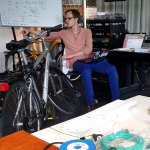Lecture 5: Understanding listening through context
Last nights Live Electronics student concert at UdK Conzert Salle. Good to hear the variety of approaches, we sitting on the polished floor, sounds morphing and moving through us, serious performers striding backwards and forwards, the summer stormed leaves slapping silently behind.
10am. Studio 1. Audio Communications Group, 3rd floor, TU Berlin.
Lecture 5. Understanding listening through the use and variety of contexts. Continuing from last week, we begin by listening to Espèces d’espaces,(2002) one of Bernard Parmiagani’s final works. We’re interested in his different, momentary and precise use of various field recordings throughout : voices, birds, bees, thunder, a crow and finally voice that’s morphed to abstraction but percussively played between L and R speaker as if chatting. These moments act as conduits to the ‘real’ world, creating a way in for unfamiliar ears and at the same time destroying any abstract world an involved listener might be in. Each time he does this, the moments become more abstracted so that the departure from the place he’s making for us is less. At the same time, he’s using familiar techniques, such as melody which appear in small filtered moments creating tension and expectation to seduce us with.
Then its Acoustic Ecology, R.Murray Schafer, Hildegard Westekamp and soundscapes. Again a practice that requires reduced listening, but the approach with context is utterly different. Again using recordings as the technique, sounds are recorded and then re-placed into the ears of the listener wherever they choose to listen. We listen to Kit’s Sound walk(1989) and discuss Westekamp’s use of essentially narrative voice. Again the context she takes us to is quite destroyed by her descriptive voice which becomes more fabled as she proceeds.
Maryanne Amacher’s approach is quite different. Her three year listen in on the Boston harbour, piped by telephone line to her studio being unknown to many. Also that her reason for doing this was not so much wanting to hear the harbour sounds but more to listen to what she was hearing in shape, form and dynamic so as to be able to try to understand how we hear and then use that understanding to compose. Psychoacoustics. Curious that this field and knowledge that humans create other harmonic tones in their ears when listening creating subliminal meaning is something so hidden for so long.
The approaches of the bicrophonic composer can be wide ranging. Moving human hearing systems of vastly different listening skills riding through changing sonic landscapes and that’s before anything is coming out of the speakers or the visua landscape is considered.





